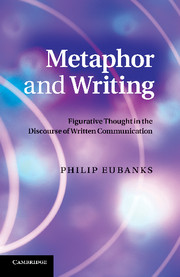Book contents
- Frontmatter
- Contents
- List of figures
- List of tables
- Acknowledgements
- Introduction
- 1 In search of the figurative rhetoric of writing
- 2 The double bind of writer and to write: Graded categories
- 3 Bind upon bind: The general-ability and the specific-expertise views of writing
- 4 Three licensing stories: The literate inscriber, the good writer, and the author writer
- 5 Writing as transcription, talk, and voice: A complex metonymy
- 6 The writing self: Conceptual blends, multiple selves
- 7 Writing to “get ideas across”: The role of the Conduit Metaphor
- 8 Codes and conversations: The other Conduit Metaphor
- 9 Metaphor and choice
- References
- Index
Introduction
Published online by Cambridge University Press: 06 December 2010
- Frontmatter
- Contents
- List of figures
- List of tables
- Acknowledgements
- Introduction
- 1 In search of the figurative rhetoric of writing
- 2 The double bind of writer and to write: Graded categories
- 3 Bind upon bind: The general-ability and the specific-expertise views of writing
- 4 Three licensing stories: The literate inscriber, the good writer, and the author writer
- 5 Writing as transcription, talk, and voice: A complex metonymy
- 6 The writing self: Conceptual blends, multiple selves
- 7 Writing to “get ideas across”: The role of the Conduit Metaphor
- 8 Codes and conversations: The other Conduit Metaphor
- 9 Metaphor and choice
- References
- Index
Summary
This book explains how everyday figures in the discourse of writing work with – and against – each other. It may seem that we already know plenty about our everyday figures for writing, that their very familiarity is what allows them to function. Yet the workings of even our most commonplace figures – to put thoughts onto paper, to find one's voice, to write clearly or forcefully or gracefully – can be poorly understood precisely because we make sense of them so automatically.
I suspect that is one reason that current scholarship has proceeded as it has. With only a few exceptions, scholarly work on familiar metaphors for writing, which is mostly in the field of writing studies, is based solely on introspection. Writing scholars have assumed, because they have an intuitive understanding of everyday writing metaphors, that their interpretations of them – and, more troubling, their interpretations of others' interpretations – require no further confirmation.
Typically, scholars have focused on one metaphor at a time, either pointing out a particular metaphor's strengths or shortcomings (e.g., voice or the Conduit Metaphor) or proposing a novel metaphor intended to clarify a particular question (e.g., Writing As Travel or Argument As Aikido). Certainly, these critiques and suggestions are valuable. But the introspective, one-metaphor-at-a-time approach does not take into account the ways that metaphors relate to other metaphors and to other figures.
- Type
- Chapter
- Information
- Metaphor and WritingFigurative Thought in the Discourse of Written Communication, pp. 1 - 12Publisher: Cambridge University PressPrint publication year: 2010

